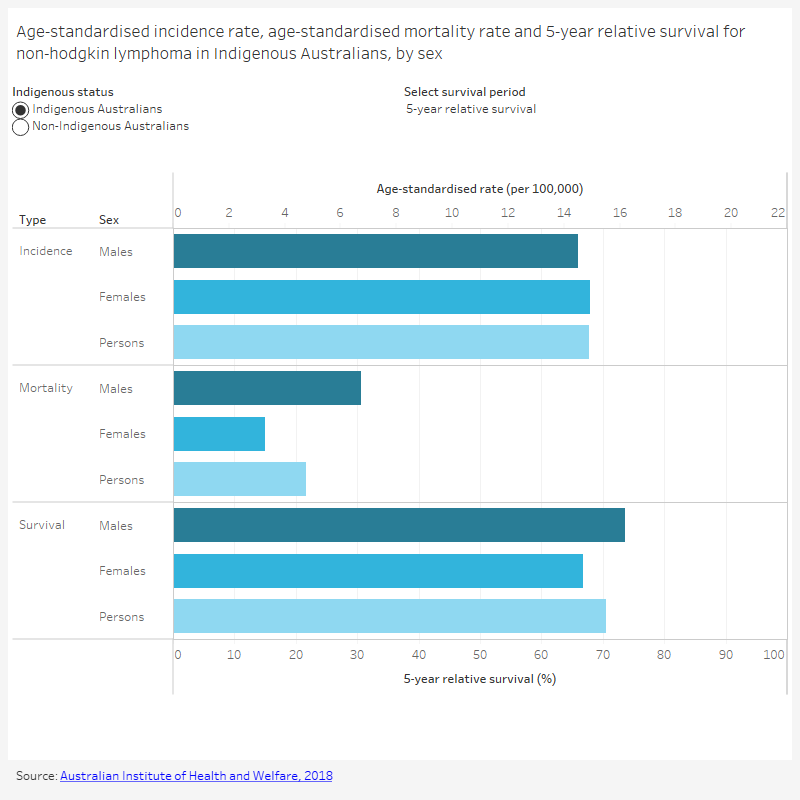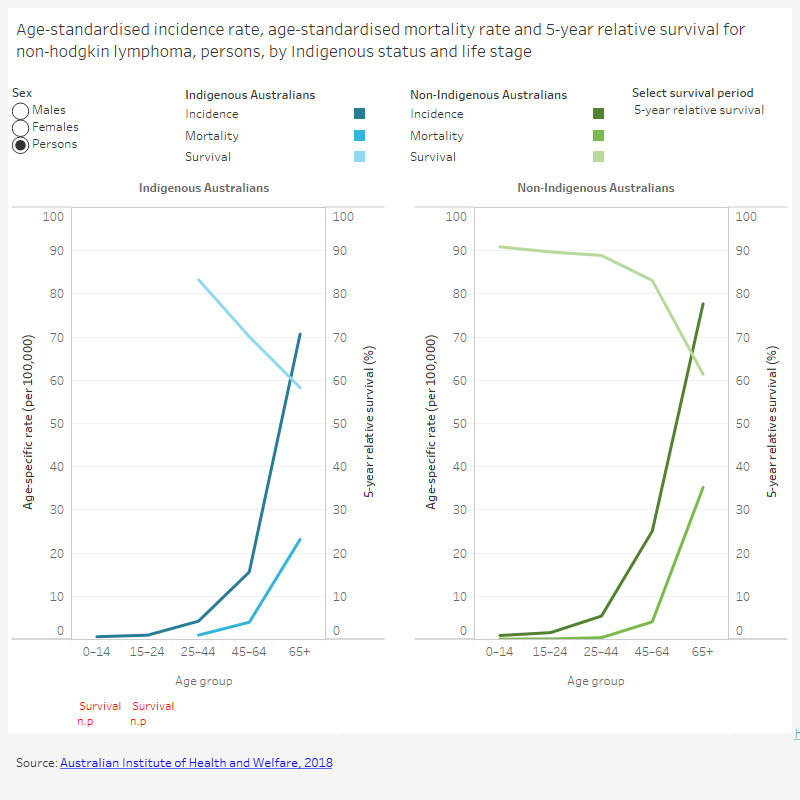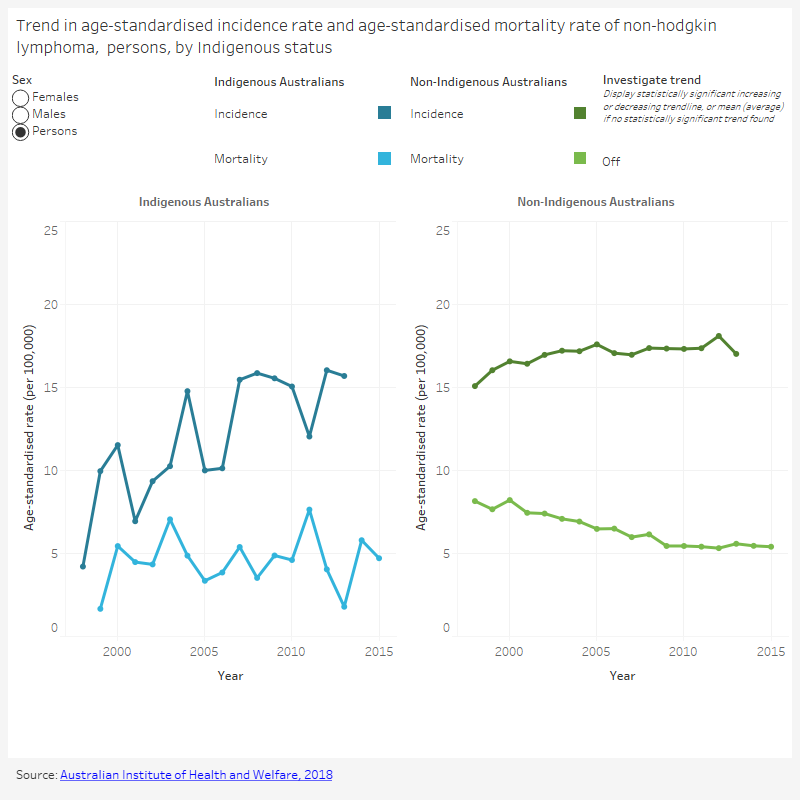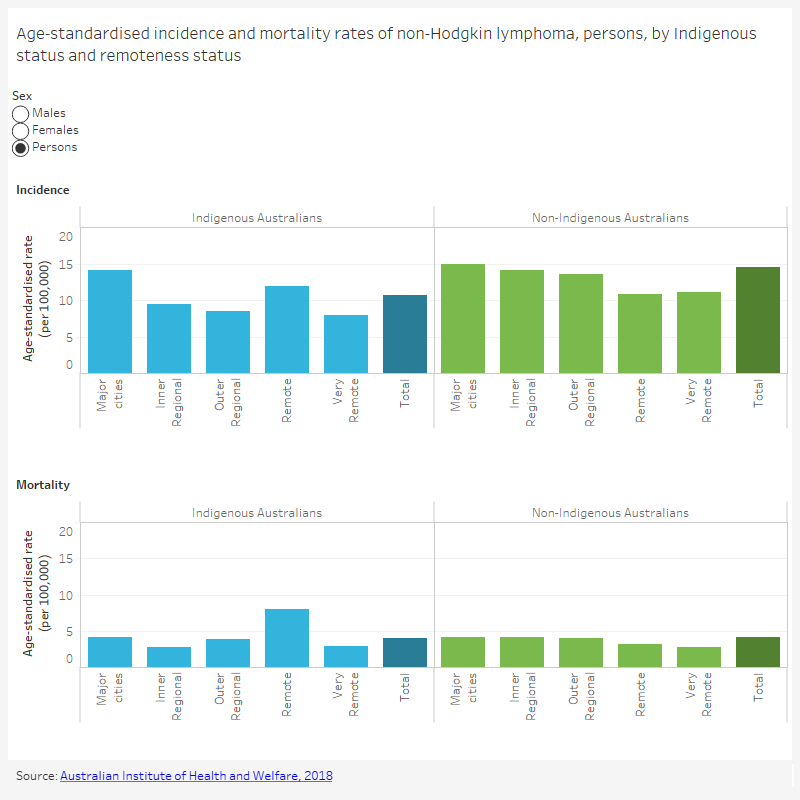Non-Hodgkin lymphoma (C82–C86)

In 2009–2013, 188 new cases of non-Hodgkin lymphoma were diagnosed in Indigenous Australians—an average of 38 cases per year. In 2011–2015, 54 Indigenous Australians died from non-Hodgkin lymphoma—an average of 11 deaths per year.
In 2007–2014, Indigenous Australians diagnosed with non-Hodgkin lymphoma had a 71% chance, on average, of surviving for five years compared with their counterparts in the Indigenous population. Non-Indigenous Australians diagnosed with non-Hodgkin lymphoma had a 72% chance, on average, of surviving for five years compared with their counterparts in the non-Indigenous population.
Sex
A similar number of Indigenous males and females were diagnosed with non-Hodgkin lymphoma. More Indigenous males than females died from non-Hodgkin lymphoma. Five-year relative survival was lower in Indigenous females than males.
Explore the data below for information on incidence (2009–2013), mortality (2011–2015) and relative survival (2007–2014) by sex and Indigenous status.

Life stage
For both Indigenous and non-Indigenous Australians, the age-specific incidence and mortality rates for non-Hodgkin lymphoma increased with each life stage.
For Indigenous Australians, five-year relative survival decreased with each available life stage. Five-year relative survival for non-Indigenous Australians was similar between life stage 0–14 and 45–64 and decreased in life stage 65 or older.
Explore the data below for information on incidence (2009–2013), mortality (2011–2015) and relative survival (2007–2014) by sex, Indigenous status and life stage.

Trend
For Indigenous Australians, the age-standardised incidence rate for non-Hodgkin lymphoma has increased over time, while the mortality rate has varied over time. Estimated trend lines indicate a significant increase in the non-Hodgkin lymphoma incidence rate. No statistically significant increasing or decreasing trend was observed in the non-Hodgkin lymphoma mortality rate for Indigenous Australians from 1998 to 2015.
For non-Indigenous Australians, the age-standardised incidence rate for non-Hodgkin lymphoma has increased, while the mortality rate has fallen. Estimated trend lines indicate a significant increase in the non-Hodgkin lymphoma incidence rate and a significant decrease in the non-Hodgkin lymphoma mortality rate for non-Indigenous Australians.
Data for individual years have been presented for trend figures to demonstrate the variation in rates from year to year. Estimated trend lines have been applied to figures based on a least-squares regression equation where trends were found to be statistically significant. Differences between the rates for Indigenous and non-Indigenous Australians may be related to a range of factors including differences between the two populations in the prevalence of risk and/or protective factors such as smoking, alcohol consumption, access to health-care services and uptake of screening and diagnostics testing.
Explore the data below for information on incidence and mortality by sex, Indigenous status and year.

State and territory
For the jurisdictions for which data were available (see Summary or Notes section for details), the age-standardised incidence rate for non-Hodgkin lymphoma ranged from 8.0 new cases per 100,000 to 32 per 100,000 for Indigenous Australians. For non-Indigenous Australians, the incidence rate ranged from 17 per 100,000 to 18 per 100,000.
For the jurisdictions for which data were available (see Summary or Notes section for details), the age-standardised mortality rate for non-Hodgkin lymphoma ranged from 1.5 deaths per 100,000 to 5.3 per 100,000 for Indigenous Australians. For non-Indigenous Australians, the mortality rate ranged from 3.9 per 100,000 to 6.4 per 100,000.
Observed differences may be due to differences in population characteristics, for example, Indigenous Australians are more likely to live in remote areas of Australia than non-Indigenous people.
Explore the data below for information on incidence (2009–2013) and mortality (2011–2015) by sex, Indigenous status and state and territory.

Remoteness area
For Indigenous Australians, the age-standardised incidence rate for non-Hodgkin lymphoma ranged from 8 per 100,000 to 14 per 100,000 across remoteness areas. The age-standardised mortality rate for non-Hodgkin lymphoma ranged from 2.8 per 100,000 to 8.1 per 100,000 across remoteness areas.
For non-Indigenous Australians, the age-standardised incidence rate for non-Hodgkin lymphoma ranged from 11 per 100,000 to 15 per 100,000 across remoteness areas. The age-standardised mortality rate for non-Hodgkin lymphoma ranged from 2.7 per 100,000 to 4.1 per 100,000 across remoteness areas.
Explore the data below for information on incidence (2009–2013) and mortality (2011–2015) by sex, Indigenous status and remoteness area.



